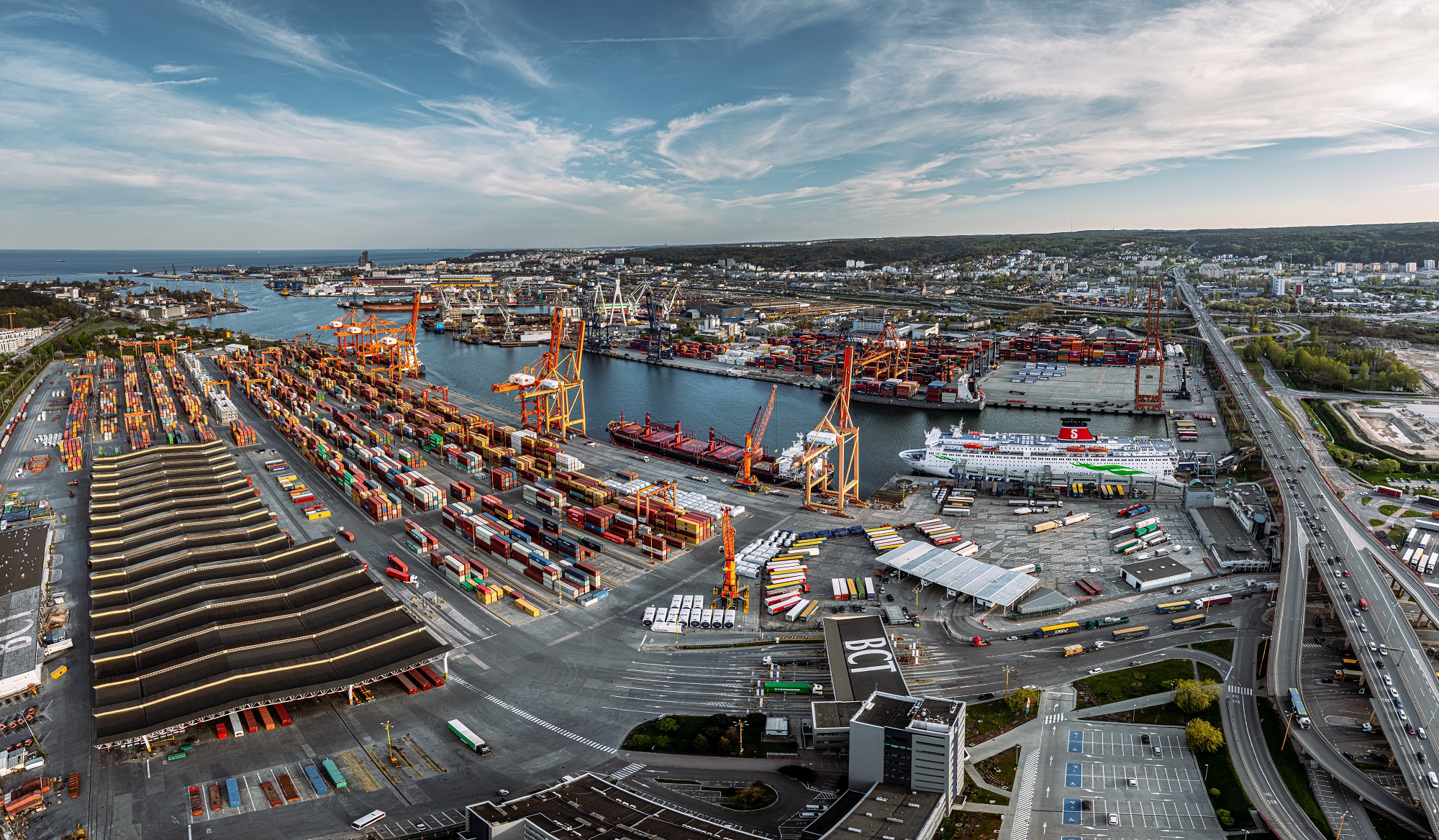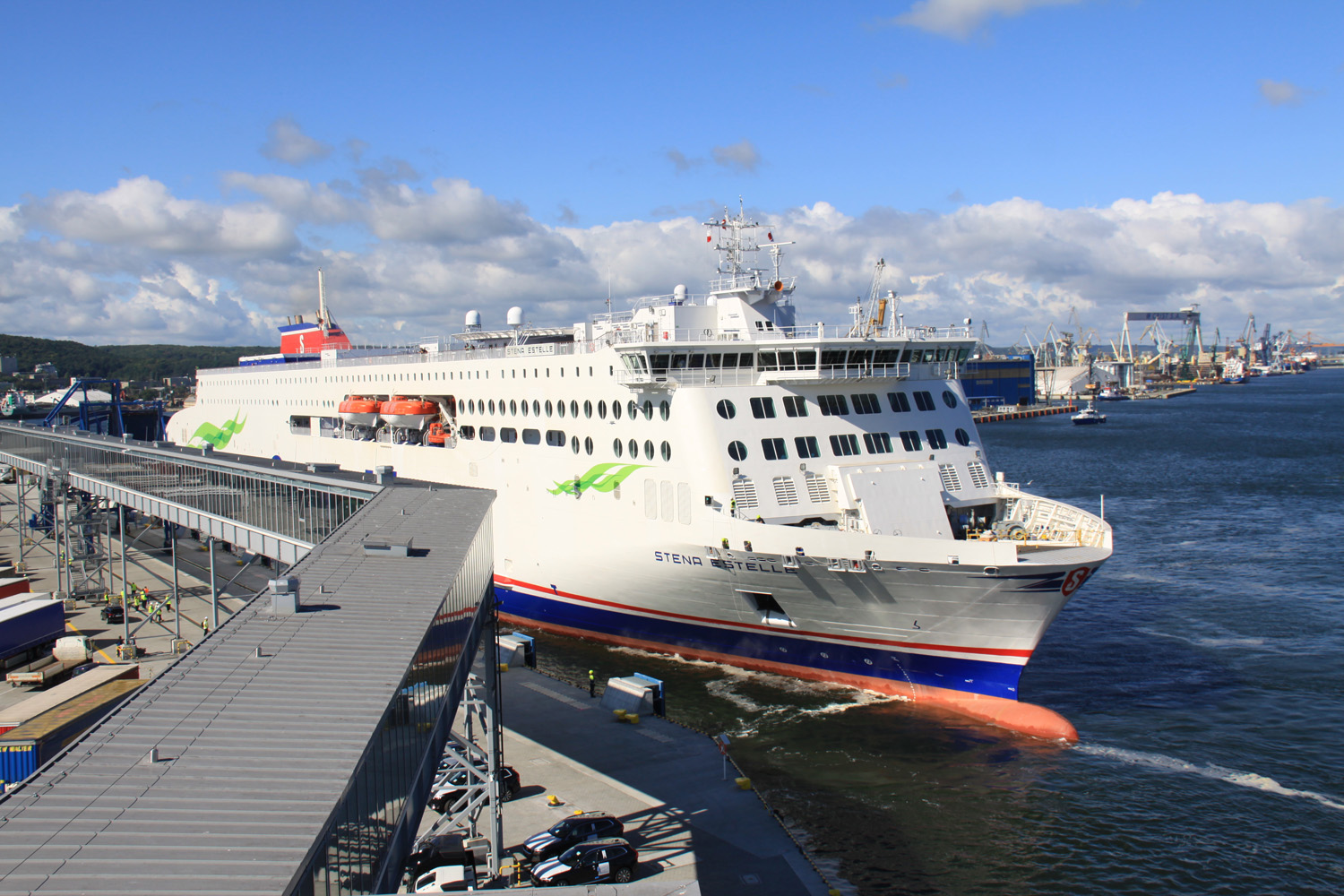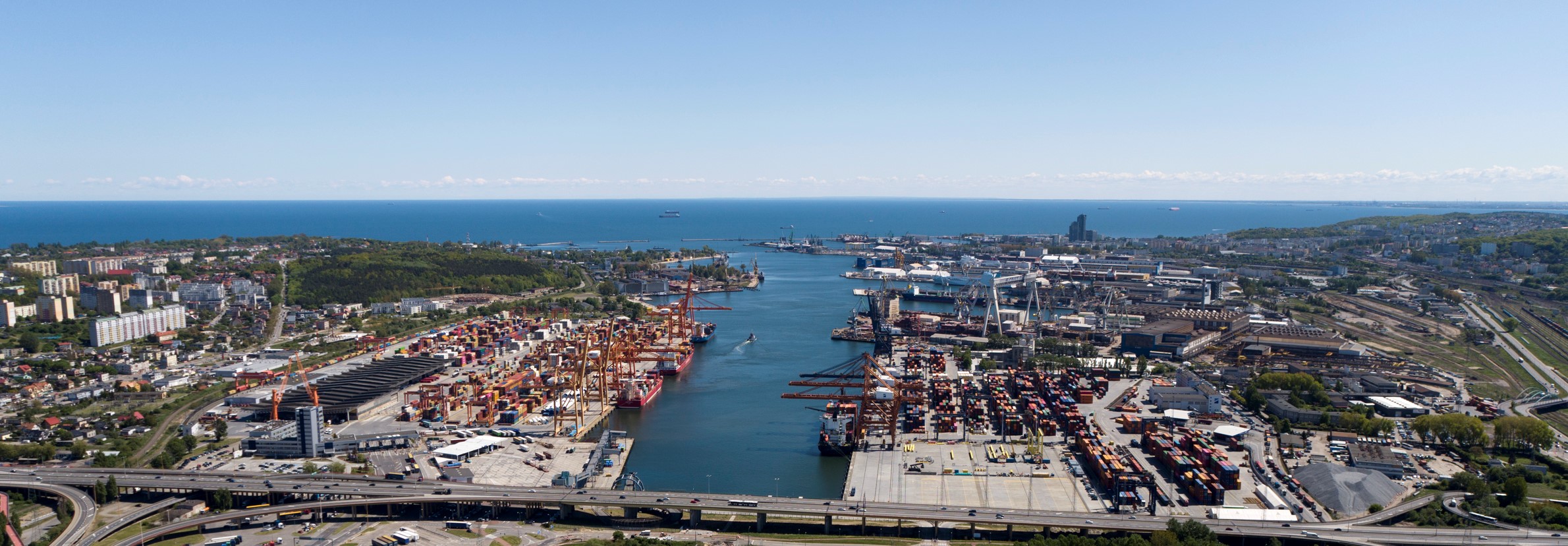28 October 2022
This month ESPO takes you to Poland, and more precisely to the Port of Gdynia, with Mr. Jacek Sadaj, CEO of the Port of Gdynia Authority S.A. In this Port pro of the month, learn more about Mr. Jacek Sadaj who is celebrating this year the 100th anniversary of this port.

1. The Port of Gdynia is celebrating its centennial. Could you explain us why it was decided to create a new port in Gdynia 100 years ago?
Port of Gdynia epitomises the regaining of political-economic independence of the Polish State after the end of the Great War in 1918 as well as territorial decisions of the Treaty of Versailles. Beginning 1920, Poland took over part of the Pomerania and a seacoast section – a narrow strip between a Kashubian village of Gdynia and the so called ‘Free City of Gdańsk’ verging on its borders. Certain privileges were granted to Poland to avail itself to the existing port facilities within the Free City of Gdańsk territories, but for various reasons – political, economic, and technical – the Poles could not expect that port to afford smooth servicing to the entire cargo volumes of Poland’s seaborne foreign trade. The factor to accelerate the port development in its early existence stages were the Customs War with Germany (closed its borders to Polish coal) and the coal miners’ strike in England, coal exports having been the main commodity urging for port investments and launching permanent connections to UK and, above all, Scandinavia. However, there were also other commodities, both import and export items, calling for new quays, cargo – handling facilities and roofed storage space, insufficient in Gdańsk. Consequently, Poland’s vital interest, by restoring its statehood and guided by a sound maritime outlook, found a solution by constructing the Port of Gdynia. It soon turned out to be the greatest and most modern port of Poland and by its cargo volume handled and turnovers, soon distancing several commercial ports in Europe, including Copenhagen, Bremen, Amsterdam, Genova etc. Nowadays, Gdynia is servicing most of the European markets and complementary with other vital Polish ports – Gdańsk and Szczecin – Świnoujście, handled all together more than 113 million tonnes in 2021, a steady increase by 8,9%, comparing to 2020.
2. Can you briefly present us the Port of Gdynia anno 2022? What are its main characteristics, main business activities and challenges?
Port of Gdynia is a universal port, one of the leading ports in the South Baltic Sea Region. It specialises in handling general cargo, mainly unitised cargo transported in containers and in a ro-ro system. Ports’ activities base on well-developed network of regular container, ro-ro, and ferry connections, including short sea shipping (SSS) services. An important role in the port’s activity is played by well-equipped bulk terminals. Diversification of transhipments increases the attractiveness of the port's offer and reduces dependence on economic fluctuations on individual markets. Such a strategy is also compatible with the natural predispositions of the port. This is why the cargo handling in the port is year by year increasing, in 2021 total turnover estimated 26,7 million tonnes (+8,3 %), being the only Polish and only one of a few maritime ports in Europe with a permanent positive annual turnover in the years 2015 – 2021. In 2022, the situation in terms of cargo handling seems to be very positive. In some cargo groups we are experiencing massive increase (‘other bulk cargo’ by 35,7%, ‘non bulk’ by 5,1 % or ‘wood’ by 611%). The main challenge for our port, being nowadays a large construction site, is accomplishing all ongoing multimodal investments, by 2030, strengthening our market position by becoming fully accessible and effective, both responding to market demand and TEN-T policies.

3. What is your long-term vision for the Port of Gdynia? What are the main investment projects for the coming years?
Our long-term vision focuses on being a multimodal and universal port, a logistics node in the North-South Transport Corridor, which can create and provide value-added services to the market. Port of Gdynia is realising its strategy by expanding of the port’s infrastructure to support oceanic ships operations, the development of motorways of the sea, adequate transport accessibility (road and rail) to the "port gates" in order to effectively service terminals, and integration with logistics facilities are of fundamental importance for the development of the Port of Gdynia. Nowadays, Port of Gdynia is a large construction site, and many investment projects are underway. It is a challenge to shortly describe them and indicate its utmost importance, because we consider the port as one intermodal terminal. Currently, works are carried out in the pre-investment process of building the so-called Outer Port, i.e. a new hydrotechnical facility on the extended waters of the gulf with 4 berths for container ships with a maximum length of 430 meters and a draft of 15.5 meters, a turntable with a diameter of 860 meters, enabling the rotation of ships up to 430 meters in length, and breakwaters of the new infrastructure on the north side. Work is also in progress, in cooperation with the Maritime Office in Gdynia, on the dredging of the approach fairway and internal waters of the Port of Gdynia, including the extension of the Turntable No. 2 with the reconstruction of the Gościnne Quay, which will enable the rotation of 366 meters long vessels in the internal waters. An investment to deepen the port channel to 16 meters is in progress, and the approach fairway to 17 meters, to accommodate ships with an ocean draft (up to 15 meters). It is worth mentioning that the Port of Gdynia is the largest grain port in Poland and an important ferry and ro-ro node. The expansion of the port’s infrastructure and facilities in this matter will increase the capacity of the port ro-ro terminals and the entire commercial connection between Poland and Scandinavia. The service of larger vessels will also be possible thanks to the deepening of the channels. Moreover, new public ferry terminal is already in operation and enable to service the largest and most eco-friendly ferries in Europe. The number of freight units on MoS Gdynia - Karlskrona has increased by 740% during the last 18 years. Freight volumes are expected to increase to 330 000 heavy goods vehicles in 2040. Parallelly, construction of intermodal infrastructure in the Logistics Centre is ongoing as well as large development of railway access.
4. The Port of Gdynia is a core port of the Baltic-Adriatic corridor of the Trans-European Transport Network (TEN-T). Has your port already been awarded any projects? Can you explain why a financing mechanism such as the Connecting Europe Facility is important for your port?
Connecting Europe Facility (CEF) is of paramount relevance for the Port of Gdynia. It enables the implementation of the TEN-T policy as well as the European Green Deal and is an important enabler towards the Union’s decarbonisation. The added value of a certain investment must be considered in a wider context. From our port’s perspective, further improvement and upgrade of the existing logistic facilities and infrastructure, including road and rail last mile connections inside and outside port areas, are required to support interconnectivity between the ports and their hinterlands and to strengthen the competitiveness of intermodal transport and Motorways of the Sea (European Maritime Space). Improved conditions for transit traffic via Motorway of the Sea would improve accessibility and the environment from international, regional, and local perspectives. Digitalisation, in this matter, will facilitate planning of investments and increase synergies of cross - border policies, as stated in ‘European Maritime Space Motorways of the Sea Detailed Implementation Plan’, and support the transition towards a more sustainable maritime sector. By means of CEF, Port of Gdynia is realising a development project upon intelligent truck traffic management system in the Port. We are also carrying on, since 2021, a new CEF project for studies, environmental assessment, conceptual and construction designing upon expanding the potential of ferry, ro-ro, intermodal facilities in the Port of Gdynia. It has a European added value as we further develop our short sea shipping connections with Scandinavia, in line with TEN-T policy.
5. Given the closing of different Ukrainian Black Sea ports and the restricted operations on the Black Sea because of the Russian invasion in Ukraine, Polish ports are playing an increasingly important role as gateway for Ukraine. What is the impact for your port? Are there any challenges or specific needs linked to this sudden change?
Europe is facing a hard and long-term consequence of the Russian invasion in Ukraine. Europe’s ports are playing a crucial role in keeping supply chains operational and in setting up new alternative routes, including solidarity lanes for Ukrainian exports. We totally confirm the ESPO’s Valencia Declaration as of 2022. Moreover, ‘Solidarity Lanes policy’ seems to be a very reasonable solution, especially by securing flow of goods from Ukraine, i.e. additional freight rolling stock, lorries, capacity of terminals, accelerating procedures on border crossings (4 of them directly with Poland). The main challenges from the Polish ports’ perspective is now investing in rail network (EU standard rail gauge widths), as well as new TEN-T connections via Lviv-Kiey-Marioupol, in the framework of the reconstruction of Ukraine. Moreover, new infrastructural investments (Via Carpathia corridor) on the western Polish (EU) border enable to secure support for our Eastern Partners in terms of cargo flows. Via Carpathia initiative launched back in 2006, turned to be of prophetic significance in terms of incumbent circumstances. From the market point of view, Port of Gdynia has no connections with Russian ports whatsoever. There are also no imports incoming from Russia. Notwithstanding, the coal imports are now more diversified and bulk terminals are part of new chains.
6. The EU, with its Green Deal ambitions and the recently published REPowerEU plan, is striving to get independent from Russian fossil fuels as well as climate neutral by 2050. As an energy port, how do you anticipate the projected changing energy landscape in Europe? What will be the main challenge?
The Port of Gdynia has its ‘green port’ approach. We are realising project related to economic energy transformation, including alternative fuels (LNG to vessels), renewable energy sources (solar panels on the ports’ buildings rooftops), electromobility facilities (both for vessels and cars), as well as working on port’s hydrogen potential. The energy system transition is a day-by-day reality, yet it requires necessary investments from the national and EU level. Moreover, the energy prices are a massive challenge to be met considering growing economic imbalances.

7. To get goods to the desired destinations, good hinterland connections to the port are of paramount importance. Can you briefly describe how the Port of Gdynia is connected to its hinterland?
Gdynia is a key port gateway of TEN-T Baltic-Adriatic Corridor (BAC) with its primary transport infrastructure. The railway links form the European Freight Corridor No. 5, the road connections of E-75 and E-77 have the European status, while the maritime stretches compose short sea shipping connections with many Baltic ports as well as an important Motorway of the Sea (MoS) between the ports of Gdynia and Karlskrona. At the same time, Gdynia serves as a key node where the last mile TEN-T corridor infrastructure mixes with the infrastructure for regional and local traffic. The current last mile access networks are not able to carry the flows, forecasted to almost double in 2027, and nearly triple in 2045 This threatens Gdynia port’s capability to long-term serve supply chains in the global and the Baltic trade dimensions. Geographic location determines the port’s further development. Currently, two main hinterland investments, both vital for the port – ‘Railway line no 201’ and ‘The Red Road’ (direct TEN-T road connection) are in progress and planned to be finished by 2028. The road must comply with TEN-T requirements - 11.5-ton axle-load capacity and standards of the high-quality roads, as stipulated in article 17 of the Regulation (EU) 1315/2013. Therefore, further integration of Gdynia port with the hinterland is crucial for the development of short-distance connections. It should be noted that nowadays seaports are becoming key links in the global supply chain, and competition between ports is focused on their support area and catchment area. Most seaports, however, compete for contentious facilities, therefore the quality, time and price of the back-end feeder service determine the competitiveness of a given port. An integrated cooperation of stakeholders in the communication chain is therefore essential.
8. The Port of Gdynia recently became a member of ESPO’s EcoPorts Network. Can you briefly tell us the highlights of your port’s environmental policy? What can a port authority do to engage all stakeholders in making their operations more sustainable?
Nowadays, we are realising our sustainable strategy in this matter up to 2027. This means a business-friendly port offering high quality port services and maintaining the highest international standards, especially in the scope of safety to ships, cargo, and passengers as well as environmental protection procedures. What is more, all new investments projects are implemented according to environmental standards, including Yetisense System (monitoring of dust), OPS (new ferry terminal), railway electrification system, LNG for vessels. For instance, in 2021 we have finalised one of the most modern ship-generated waste systems in the Baltic. The system’s highest technological parameters secure its environmental effectiveness to all the stakeholders, including local residents. From a broader, landside perspective, one has to notice though that Port of Gdynia is surrounded by urban areas and in fact there are no terrain to be redeveloped in terms of port infrastructure. This is highly challenging. There is only one solution for this problem, on one hand, building infrastructure on the extended waters of the gulf, and on the other hand, investing in the so called ‘Logistic Valley’ in the hinterland. The area is included in the border of the Port of Gdynia is approximately 1.5 km from the western border of the port and will constitute an enclave with direct access to the port quays following the implementation of the ‘Red Road’. As part of the 'Logistic Valley', it is planned to build a logistics service centre, a central car park (for 1000 trucks), a public intermodal terminal, road infrastructure, depot, and network infrastructure. We are engaging stakeholders in this matter. Local communities are also aware of its necessity.
9. European ports are increasingly investing in digital solutions to improve the efficiency of the logistics chain and port operations. Has the Port of Gdynia taken any initiatives towards digitalisation?
Port managing bodies have a pivotal role in the digitalisation of the supply chain as facilitators between all parties involved in port operations, both sea - shore and port - hinterland. Port of Gdynia is working on effective digital solutions, awarded and recognised by the international community, i.e. KAPI system (digital railway pre-arrival notification), GBAS-RTK system (vessels’ navigation), Port Community System (together with maritime ports in Gdańsk and Szczecin – Świnoujście), Digital Twin project (port’s infrastructure stocktaking), as well as Intelligent Truck Traffic Management System.

Related documents
No attachments.

